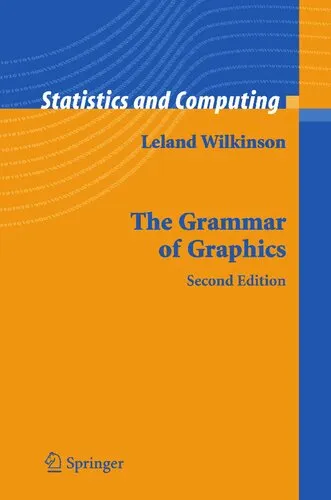The Grammar of Graphics (Statistics and Computing)
4.5
بر اساس نظر کاربران

شما میتونید سوالاتتون در باره کتاب رو از هوش مصنوعیش بعد از ورود بپرسید
هر دانلود یا پرسش از هوش مصنوعی 2 امتیاز لازم دارد، برای بدست آوردن امتیاز رایگان، به صفحه ی راهنمای امتیازات سر بزنید و یک سری کار ارزشمند انجام بدینمقدمه کتاب "The Grammar of Graphics"
کتاب "The Grammar of Graphics" اثری پیشگامانه در حوزه تحلیل دادهها، مصورسازی آماری و علم داده است که توسط "Leland Wilkinson" و همکارانش تألیف شده است. این اثر ابعاد مختلف مصورسازی دادهها را با استفاده از یک چارچوب مفهومی و انعطافپذیر توضیح میدهد. در دنیای امروز که دادهها نقشی اساسی در تصمیمگیری ایفا میکنند، این کتاب به کاربران، پژوهشگران و متخصصان این امکان را میدهد تا به شکلی دقیق و علمی، ارتباطات بصری داده را طراحی و تفسیر کنند.
"The Grammar of Graphics" نهتنها برای متخصصان علم داده و آمار، بلکه برای هر کسی که به دنبال درک اصول محوری مصورسازی و تجزیهوتحلیل دادهها است، یک منبع کلیدی محسوب میشود. هدف اصلی کتاب، ایجاد یک زبان مشترک برای توضیح و خلق مصورسازیهایی است که پیچیدگی اکثر ابزارها و نرمافزارها را کاهش دهد.
خلاصهای از کتاب
این کتاب به چهارچوبی سیستماتیک به نام Grammar of Graphics پرداخته که پایه و اساس بسیاری از ابزارهای مدرن مصورسازی داده است (مانند ggplot2 در زبان R). "Grammar" به معنای دستور زبان است و این نامگذاری از شباهت مفهومی بین زبانهای نوشتاری و زبان مصورسازی الهام گرفته شده است. این چارچوب به جای تمرکز سطحی بر ابزارها و نرمافزار خاص، به جنبههای مشترک و بنیادین هر مصورسازی نظیر دادهها، معنا و طرح میپردازد.
بسیاری از افراد گرافیکها را بهعنوان نقاشی یا طراحی ساده میبینند، اما این کتاب نشان میدهد که مصورسازی در واقع یک فرآیند علمی است که شامل جمعآوری دادهها، پردازش مقیاسهای اندازهگیری، تنظیم متغیرها، و طراحی نمادها میشود. با پیروی از ساختار این کتاب، خوانندهها میتوانند فراتر از مصورسازیهای سنتی حرکت کرده و بصورت عمیق ارتباطات میان دادهها را توضیح دهند.
مهمترین نکات کلیدی
- درک چارچوب جامع Grammar of Graphics برای طراحی و تفسیر مصورسازیها
- تحلیل ارتباط بین داده، روابط معنایی و طراحیهای بصری
- ارائه اصول جهانی و مستقل از نرمافزار برای ساخت مصورسازی
- اهمیت مقیاسها (Scales)، مختصات (Coordinates) و عناصر بصری (Visual Elements)
- مرور دقیق روشهای نوین و سنتی در نمایش دادهها
نقلقولهای برجسته از کتاب
"Data graphics are sentences about the world."
"Graphics should not only look good; they should also reveal the truth."
چرا این کتاب مهم است؟
اهمیت "The Grammar of Graphics" نه تنها در مفهومسازی دقیق و پیشرفته مصورسازی دادهها، بلکه در تأثیرپذیری آن بر ابزارهای مدرن مانند ggplot2 و Tableau دیده میشود. این کتاب بسیاری از روشهای متداول در مصورسازی دادهها را سادهسازی کرده و یک دید کلی ارائه میکند تا متخصصان بتوانند به شکلی دقیق و موثر دادهها را تحلیل و نمایش دهند.
اگرچه ابزارهای نرمافزاری مختلف میتوانند همچنان تولید گرافیکهای مناسب را فراهم کنند، این چارچوب به ما نشان میدهد که چرا برخی از گرافها موفق هستند و برخی دیگر نه. این کتاب کمک میکند تا تصمیمگیریهای آماری و بصری با دقت بیشتری انجام شود.
در نتیجه، "The Grammar of Graphics" چیزی بیش از یک منبع آموزشی ساده است. این کتاب راهنمایی برای توسعه تفکر سیستمی و درک بنیادین از چگونگی ارتباط مؤثر دادهها با مخاطبان است. بدون شک، مطالعه این اثر برای هر کسی که میخواهد مهارتهای مصورسازی پیشرفتهای داشته باشد، واجب است.
Introduction to "The Grammar of Graphics"
"The Grammar of Graphics (Statistics and Computing)" by Leland Wilkinson and co-authors is a groundbreaking book that redefines how we think about data visualization. It provides a systematic and structured approach to graphics, establishing a robust theoretical framework that underlies all data visualizations. This book caters to statisticians, data scientists, graphic designers, and anyone interested in data representation, offering a seamless blend of theory and practice.
The book's title reflects its core principle: just as grammar defines how words can be combined to form meaningful sentences, "The Grammar of Graphics" outlines how graphical components can be composed to create clear, insightful, and aesthetically pleasing visualizations. By providing a language for graphics, this text empowers readers to design, interpret, and evaluate visual representations of data in a consistent, logical, and creative way.
Detailed Summary of the Book
The book is fundamentally about constructing a unified theory of visualization. It seeks to build a compact grammar - a set of rules - that describes the process of creating and interpreting visualizations. This approach promotes the idea of separating the 'what' from the 'how.' While most tools focus on giving users immediate ways to visualize data, this book delves deeper into the principles and reasoning behind those choices.
Wilkinson and co-authors present concepts such as layers, scales, guides, and graphics components, breaking down each graphic into discrete elements that work together to convey a cohesive story. So rather than merely teaching you to create bar graphs or scatter plots, the book explains the fundamental principles that apply to all types of graphics.
Throughout its chapters, "The Grammar of Graphics" emphasizes the interplay between data, graphics, and the viewer's perception. It explores elements like aesthetics, transformations, and statistical summaries, while also incorporating philosophical and mathematical foundations. The book carefully blends technical explanations with practical examples, making it a valuable guide for both novice and advanced practitioners.
Key Takeaways
Here are some of the most important lessons readers can extract from "The Grammar of Graphics":
- A comprehensive understanding of the theoretical structure behind visualization design.
- Insights into building graphics systematically, rather than relying on pre-defined templates or tools.
- Appreciation for the importance of perception, storytelling, and context when creating visualizations.
- Awareness of the interplay between data, transformations, scales, and aesthetics.
- Enhanced skills for critiquing and evaluating visualizations based on rigorous principles.
- The ability to adapt this "grammar" to any visualization software, framework, or tool.
Famous Quotes from the Book
Here are some memorable and thought-provoking quotes from "The Grammar of Graphics":
"Graphics are tools for reasoning and should facilitate cognitive tasks, not merely decorate data."
"The goal of a graphic is not the graphic itself, but the understanding it produces in the observer."
"A unifying grammar of graphics allows us to go deeper into the structure of graphical systems, revealing their common underpinnings."
"Separating content from presentation is as critical in visualization as it is in language."
Why This Book Matters
"The Grammar of Graphics" stands out as more than just a book about visualization. It is a foundational text that addresses the evolving needs of modern data analysis and visual communication. By focusing on the principles that unify all forms of visual representation, this book provides readers with a versatile framework that they can apply to any domain or field.
The book holds particular significance in the era of big data, where clear and accurate communication of information has become a cornerstone of success. For data scientists and analysts, it fosters a deeper comprehension of how to design effective graphics, going beyond surface-level visual appeal. For educators, it provides a pedagogically sound base for teaching visualization techniques. For developers of visualization software, it serves as an inspiration and blueprint for implementing robust and flexible solutions.
In short, "The Grammar of Graphics" empowers its readers to not only become better creators of visualizations but also more thoughtful critics and consumers of them.
دانلود رایگان مستقیم
You Can Download this book after Login
دسترسی به کتابها از طریق پلتفرمهای قانونی و کتابخانههای عمومی نه تنها از حقوق نویسندگان و ناشران حمایت میکند، بلکه به پایداری فرهنگ کتابخوانی نیز کمک میرساند. پیش از دانلود، لحظهای به بررسی این گزینهها فکر کنید.
این کتاب رو در پلتفرم های دیگه ببینید
WorldCat به شما کمک میکنه تا کتاب ها رو در کتابخانه های سراسر دنیا پیدا کنید
امتیازها، نظرات تخصصی و صحبت ها درباره کتاب را در Goodreads ببینید
کتابهای کمیاب یا دست دوم را در AbeBooks پیدا کنید و بخرید


